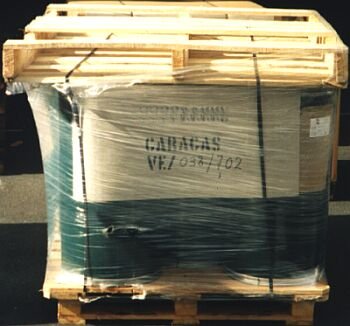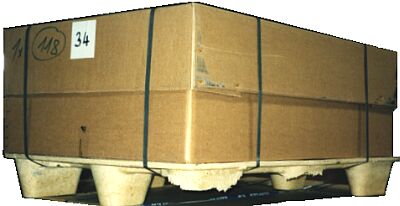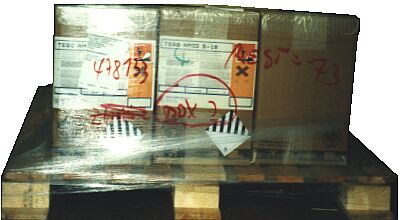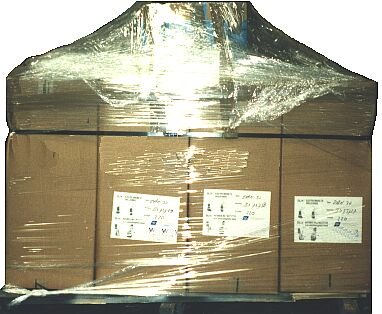Continued from Section 4.1.2.1: The influence of faulty unitization and palletization on load securing
 |
Load dimensioned to suit the internal measurements of the container |
This example also shows that the dimensions of packaging receptacles can be designed to fit the internal dimensions of the containers themselves. Transportation modules of this type can help save costs.
| Faulty unitization |  |
The strapping as shown above is faulty. This method is unable to provide a stable unit load. The unpleasant tendency of corrugated drums to ride up over the corrugations can be prevented by appropriate unitization on pallets, but this will still not cure the tendency of pallets to ride up against each other.
Four drums with a maximum diameter of 585 mm can be stowed next to each other in standard containers. From the loading point of view, the most sensible option is to use drums with wide corrugations and a diameter of 580 mm, loaded onto pallets with dimensions of 1,160 mm x 1,160 mm.
 |
Acceptable form of unitization |
Formation of a unit load in the format shown above is acceptable, but its quality should not be overestimated. Since the strapping is vertical, it is unable to provide resistance to shifting. As a result, the top wooden board can easily shift. Diagonal strapping would be ideal but is extremely difficult to implement.
The picture below makes this problem clear.
 |
||
| Diagonal shifting of the "lid" of a unit load | ||
The "lid" used for this unit load is an inverted pallet. In this case, only two straps have been used for unitization but at least the drums were wrapped in shrink film first. Nevertheless: simply as a result of the transportation by road from the shipper to the container packing station, the "lid" has already shifted.
In series production it would make sense to affix a "lozenge" to both the pallet and the lid which would ensure a 100 % tight fit for the drums after strapping:
 |
||
| Pallet and lid with "lozenge" can guarantee a tight fit. | ||
 |
Side view of the strapped pallet |
In order to reduce the risk of torn strapping, it would make sense to introduce pallets and lids which have grooves cut specifically to take straps.
 |
||
| Catastrophic unit load | ||
This example also requires additional effort in order to guarantee that the plastic canisters reach the recipient in an undamaged state.
The pictures below provide particularly vivid examples of poor packaging and unitization: Wooden feet that extend beyond the pallet/or are higher than they are wide always cause problems during loading, packing and securing. The loaded surface area is too small and results increased loads on the cargo stowed underneath. Even experienced stowage and loading personnel can only partially compensate for this by using additional dunnage.
 |
 |
 |
||
| Note: It's a well-known fact that small feet, narrow and tall, are likely to collapse. |
||
The use of steel strapping to hold packages in place should be avoided. The use of steel strapping without any edge protectors is particularly critical.
 |
 |
|
| Unsuitable "feet" on packaging receptacles Note: Stability comes when the wide edge is facing down. |
||
Even the slightest of lateral forces are enough to collapse the feet of this plywood case. This combination package shows an "ALTO" arrow which simply indicates the top of the item, and not "transport this way up".
This selection of frequently observed packaging faults is just the tip of the iceberg. There is also a whole range of other weaknesses that indicate that the transportation of goods in general, and the packing of containers in particular, are operations that do not always run as smoothly as they could.
The requirement laid down in virtually all national and international legislation, regulations and agreements, namely that goods should be "packed safely" is unfortunately all too frequently not put into practice.
  |
|
| Very poorly wrapped unit loads |
These unit loads have fallen apart when being transported from the warehouse to the loading ramp on the company premises - despite being very carefully deposited by the forklift operator.
 |
Insufficiently wrapped carton on a Europallet |
Companies very rarely respond appropriately and immediately when confronted with badly packed goods, despite the fact that they have the opportunity to do so.
Generally the shipper is responsible for all consequences caused by a lack of packaging or by poor quality packaging. In particular, the shipper is responsible for compensating companies for damage caused as a result of such faulty packaging.
 |
||
| Consolidated package that is unsuitable for transportation | ||
A company which accepts goods for carriage that already show obvious evidence of damage is entitled to demand that an entry is made in the consignment note by the shipper documenting the state of the goods explicitly.
 |
||
| Load that is only fit for writing off | ||
Pallets that are not loaded flush require additional securing. The badly applied steel strapping requires particular care when handling these loads using a forklift truck since they are easily torn away when applied in this manner. It is very difficult to assess whether or not the damage to the carton has also resulted in damage to the goods inside it or will do so subsequently.
If the lack of packaging/faulty packaging is not entered in the shipping documents by the shipper or the party delivering the consignment, then the company responsible for the onward transportation is required to document these faults.
 |
||
| Fit for writing off: Crates without sufficient diagonal bracing |
||
Every wooden crate that does not have sufficient diagonal bracing should be classed as faulty packaging.
 |
||
| Fit for writing off: Crates without sufficient diagonal bracing |
||
The lack of diagonal supports has already caused deformation of this wooden crate. Depending how sensitive the packed goods are, this deformation could cause damage. In addition, this example shows evidence of loading and securing errors.
 |
||
| Damaged chipboard pallet | ||
As observations in many container packing stations have shown, pallets made of chipboard are not suitable for overseas transportation purposes. They are too weak and are very susceptible to damage. As a result of the very small surface areas of their feet, they also apply high loads to the objects they are standing on and can thus often only be used in conjunction with materials that are able to distribute this load.
 |
||
| The damaged feet of a chipboard pallet pose a risk to other goods. |
||
Chipboard pallets are easily damaged even when subjected to very low loads. Both the sharp edges that remain and the reduction in surface area that results will further increase the loads on other cargo.
 |
||
| Insufficient wrapping of a chipboard pallet | ||
 |
Increased pressure as a result of small surface areas |
| Unsuitable solution to the problem |
 |
This pallet is too big for the carton. This causes gaps when packing the CTU. Since chipboard pallets are very sensitive to bending forces, the steel strapping may break off parts of the pallet. This means that the carton is no longer bonded securely to the pallet. In order to get around this problem, the carton and its pallet were loaded on their side. But this is not a particularly good solution because this can cause problems for handling staff and may even damage the contents.
 |
 |
|
| Unit load that is not fit for transportation | ||
 |
Unacceptable unit load |
Such badly packed pallets can only be loaded safely with a high outlay in terms of personnel and materials. The holes in the lower telescope carton indicate that an inexperienced forklift operator was entrusted with handling this pallet.
This unit load clearly shows the lack of understanding that has gone into unitizing the load. The consequence of this poor unitization will be that the packages will be split and loaded into the CTU individually.
 |
||
| In accordance with the IMDG code: Load unit that contravenes the regulations |
||
If a company is not prepared to load packages of this type individually, considerable effort must be put into correct load securing.
 |
||
| Unit load not suitable for transportation | ||
With many packages, gaps remain when the packages are loaded next to each other. In other cases, the stretch wrap is too weak or does not form a firm bond with the pallets or other bases. Other unit loads cannot be stacked or have faulty strapping etc.
 |
 |
 |
Above and left: Faulty unitization hinders the correct packing of containers |
Loads of this type make it impossible to pack the container tightly without additional work and materials.
 |
 |
Well packed unit loads are level and can be stacked. The ones shown here do not fall into this category. |
The process of packing a container is made more complicated if unit loads are delivered which cannot be stacked. If unit loads are so heavy that they cannot be packed on the top layer or cannot be fitted into this space, then the packages must be split and loaded manually.
 |
||
| Faulty unit load | ||
The faults are: No stable bond between the stretch wrap and the pallet base, the strapping cuts into the boxes, the surface is not level and thus does not allow anything to be stacked on top of it.
| The sides of the unit load are not flush. |
 |
Since the sides of the unit load are not flush, additional work is required in order to fill the gaps.
Continued in Section 4.1.2.3